Among the array of “poppets”—three-dimensional figurative sculptures made from fabric, wire, string, and beads—on display at Fountain House Gallery’s 2021 booth for the Outsider Art Fair (which was held online and at various New York City venues from January 28 through toFebruary 7, 2021), Adjustment (2020) catches my eye. In particular, the amulet, a weighty circular object comprised of intricate textures and geometric shapes accompanied by a doubled string of small beads, pulls attention to what could be a torso and divides head from arms from elongated tail—its end, tightly wound with a bright yellow string, curling upward like a mermaid. I like the contrast between the metallic charm, the softness of the magenta fabric, and the thin, hot pink string that wraps around tightly to form a body. There is an errant bead near the top which looks as if it could be a single eye, although it appears to be looking toward something imperceptible to the viewer. To be in the presence of Adjustment is to feel its energetic and aesthetic effects. It does not feel surprising, then, that artist Angela Rogers says that she was inspired by the Tarot card of Justice, and indeed, different poppets at the booth are named for other cards in the Major Arcana. Although some may interpret Justice as a sign that injustice will be righted and others see the card as a call for truth, I see these diverse interpretations presented by Adjustment as offering invitations to think about the multiple modalities of Fountain House Gallery and Studio’s mission to promote art produced by people with mental illness. As Fountain House artists gain exposure (Fountain House Gallery has had a booth at the Outsider Art Fair since 2007, for instance) they are able to be in community with one another to share ideas and techniques, and they reduce the stigma of living with mental illness.
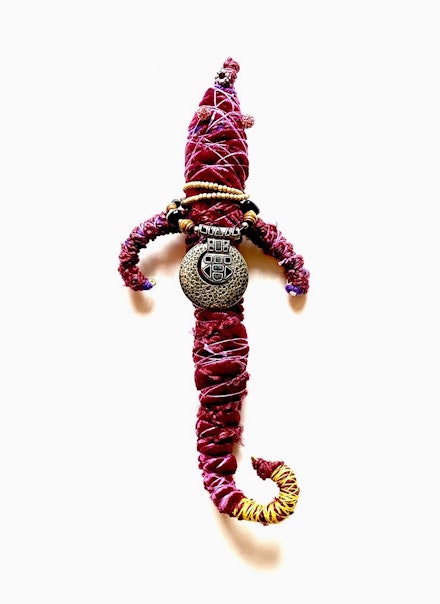
Rogers started making poppets after brain surgery in 2012 resulted in a seizure disorder. She began by wrapping twigs with yarn and string and eventually, as she narrates, “they turned into creatures and they told me what they wanted to be, what they wanted to wear, what charms they wanted on them and I began to listen to them more and more and every time I make one I’m hoping it will get a good home and somebody will love it and care for it.” Rogers’s favorite piece, Spirit Doll for Anthony Bourdain, was made for the spring 2019 Fountain House Gallery show celebrating food and cultures of eating, At the Table, curated by Monty Blanchard and Leslie Tcheyan. The humanoid black fabric figure is abundantly adorned with gold—a large gold sequin on its head, gold thread wrapped around its arms and torso, and a gold and black sequin skirt—and Rogers also added accents of royal blue, red, and neon green. The effect reflects the cosmopolitan and international sensibilities of the late chef, writer, and television personality. Rogers also included a poem in tribute to Bourdain and the pleasure he brought to her life. In addition to poetry and poppets, Rogers also paints and draws. She has been a Fountain House Gallery artist for six years and has participated in the Outsider Art Fair for 10 years—five of them with Fountain House Gallery.
Although the label of “outsider art” can mean many things—artists can be designated as such because of their use of unconventional materials, lack of formal artistic training, or marginalization from society—perhaps owing to mental illness, it most centrally engages the imbrication of biography and artistic practice in its assertion that every person’s approach to art is unique. Fountain House Gallery celebrates each of these aims by supporting and nurturing each artist’s individual form of expression. While some Fountain House Gallery artists are self-taught, others, like Laurel Burns, who received a BA from Hunter College with concentrations in black-and-white photography and ceramics, have had training. Two of Burns’s mixed media works were featured in The Creative Mind & Mental Illness, a virtual event combining awareness and a benefit auction put on by Fountain House, held in May. Patterson Sims, curator of the exhibit and member of Fountain House Gallery’s art advisory council, notes that he selected each piece of art—one or two from 39 individual artists—to highlight individuality, regardless of theme. What draws them together, he says, is their intensity and honesty. They are expressions that need to emerge. In Burns’s Waves (2020) the viewer is presented with churning green and blue ocean swells, orange and pink clouds, and a vividly blue sky, while Coney Island Seagulls (2020) situates the viewer amid a dense flock of birds perched on the sand, looking toward the unknown away from the viewer. Coney Island’s famous boardwalk, populated with sparse silhouettes, is visible in the distance. Despite their seemingly placid façades, the paintings’ emphases on the horizon line augment the pervasive feelings of looming uncertainty and isolation of our pandemic era. These paintings ask viewers to reflect on their own emotional situatedness.

Fountain House is devoted, as their mission statement on their website says, to “fighting to improve health, increase opportunity, and end social and economic isolation for people living with serious mental illness.” To be a Fountain House Gallery artist, one must be a member of Fountain House, which means that one must have a diagnosable mental illness. The origins of Fountain House date back to the late 1940s, when patients at Rockland State Hospital in Orangeburg, New York began to organize informal gatherings. The patients would gather to converse, read, and paint, in the hopes that community building among themselves would help combat the social isolation brought on by the stigma of mental illness. Once they were no longer institutionalized, a number of these original group members continued to meet on the steps of the New York Public Library to carry on lending each other mutual support. In 1948, the group purchased a building (with a fountain, bestowing the organization its name) on West 47th Street in Hell’s Kitchen with help from the National Council of Jewish Women and donations from Elizabeth Schermerhorn and Hetty Richard, who also volunteered with the nascent organization. Led by a combination of volunteers and former psychiatric patients, the group’s governing ethos, “community is therapy,” proved to be effective at reducing rates of homelessness, hospitalization, encounters with the criminal justice system, and incarceration among its participants. Today the organization’s pioneering structure, which is called the clubhouse model, has been replicated in over 300 locations throughout the nation and around the world.
But Fountain House Gallery—originally named Fountain Gallery—is unique. Founded in 2000 when Kenn Dudek, then-president of Fountain House, decided to highlight the artistic talents of members, the group transformed Fountain House’s thrift store on Ninth Avenue into a gallery. It opened its inaugural exhibit, a group show featuring the work of member-artists, on June 19, 2000. On the occasion of the gallery’s 10th anniversary, Timothy Bronkema, a volunteer, put his reflections into writing to emphasize the collective spirit that marked the gallery’s early years: “We came together in spite of our differences and meshed, forming a creative force for which our gallery is recognized. There was always room for everybody at the Gallery. Even if you were not artistic, you could help paint the walls or hang the pictures or just sweep and clean if this is what you felt you could do.” In 2005, Fountain Gallery expanded to encompass the entire street level, undergoing a major renovation, and was rechristened Fountain House Gallery in 2015.
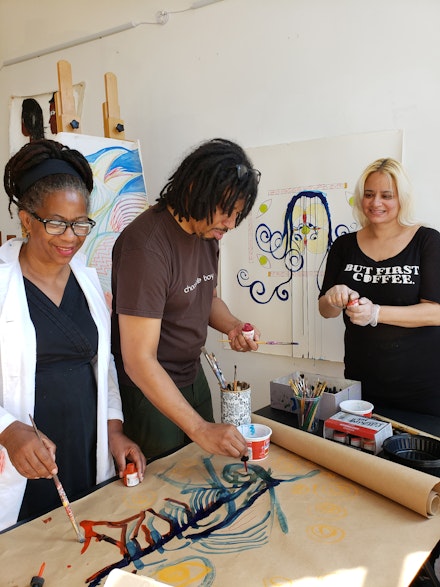
More recently, Fountain House Studio, a large collaborative workspace in the Silks Building in Long Island City, run by artist Karen Gormandy, opened in 2017. Initially a volunteer at Fountain House Gallery, Gormandy began teaching a weekly charcoal drawing class after members expressed interest. Within the span of five years, Gormandy produced a nine-week curriculum designed to be an encouraging approach to technique, art history, and tapping into artists’ unique creative impulses. Gormandy’s curriculum familiarizes artists with formal techniques, which they can then build upon to “impose their own story and style.” These sessions also serve as a way to unlearn ideas about what is considered art and what kind of art is valuable. As Gormandy notes, weekly artist talks with member-artists build community and confidence by allowing members to “become intentional and articulate about their work.” In keeping with Fountain House Gallery’s member-guided approach, this sustained interest on the part of the members led to the official launch of Fountain House Studio, which offers free art supplies, a variety of courses, and individual workspaces on a rotating six-week basis. Notably, Fountain House Studio has expansive and flexible open hours—a necessity because some manifestations of mental illness require institutional flexibility. Angela Rogers says,
When I’m in a mania I’m very productive, prolific, I’m bouncing off the walls, I feel really good, but when I crash, I feel really bad and I’m in a deep dark place where I can’t get out of my house. I isolate. It’s very hard to get out of bed. But if there can be a way that I can get up and go to the studio, I know that when I walk in, I’m going to be in the zone. There’s a zone you get into; you’re inspired to make great art. I see people make great art and I get moved to make great art myself. And I just feel like Fountain House is a place where you can share information about your mental illness without the shame or stigma about it. It’s become so critical and crucial in my life as an artist and as a person living in New York City.
Fountain House Studio is also open to the broader Fountain House community during drop-in hours. It welcomes those who may not have previously considered themselves to be artists in addition to those who are looking to build their portfolios more deliberately.
From its ranks of member-artists—any member of Fountain House with artwork to show and a commitment to the gallery—Fountain House Gallery puts together six shows a year. In addition to Gormandy, the gallery relies on a director (previous director Ariel Willmott stepped down in 2020; a new director will soon be named), and a communications advisor, Camille Tibaldeo, to interface with artists, curators, and the public. An art advisory council (of which Brooklyn Rail publisher Phong H. Bui is a member) and advisory board help orient the gallery within the larger art world by putting forth the names of potential curators and making other connections. The work of setting the year’s exhibition schedule falls to the internal steering committee with some shows curated by invitation and others selected from proposals put together by artist-curators. The only perennial exhibition is the Small Works: 100 Dollars & Under, a crowd-pleasing fall affair that allows artists to keep 60 percent of the profits; the remainder raises funds related to running the gallery. Fountain House Gallery works to provide a platform for their artists to exhibit their art and to gain a foothold in the art world—disrupting some of its norms in the process. Painter and fashion designer Guiomar Giraldo-Baron described the Gallery’s mission and its personal impact in a recent Fountain House Gallery Instagram post:
I have been displaying my work at the Gallery since the year 2014 when I joined Fountain House and the gallery. I have been able to not only showcase my work as an artist but also allow my voice to be heard. My own expression through art has been possible in part thanks to the work of Fountain House Gallery with the artists. The sense of artistic inclusion is uplifting.
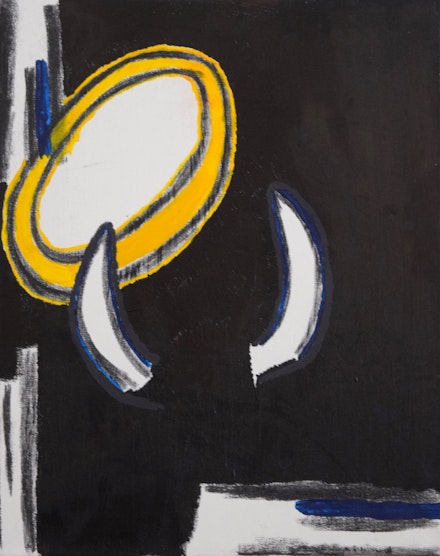
The most recent exhibit, Rigged Society / Organized Chaos, which was on view at Artsy from February 26–May 26, 2021 was co-curated by Sasha P.W. and Don’aë Tate, two Fountain House Gallery artists who met through Fountain House Studio residencies. While the ghost of Basquiat, who both cite as an influence, circulates, P.W. and Tate display their own distinct methods, ways of thinking, and politics. Both also see the role of the artist in society differently—Tate focuses on the artist as truth teller while P.W. emphasizes the importance of sharing one’s story. Tate’s paintings use large expressive brush strokes and swatches of solid color in the service of graphic imagery while P.W.’s paintings have tightly bound kinetic energy. The bold and ambitious show took the form of a conversation between the artists, and featured multiple works by each artist as well as several that have been collaboratively produced. In Desert Flower (Alternate Energies) (2019) Tate positions a tall flower—orange, brown, and yellow—with lines for petals next to a cornflower blue skin and the barest suggestion of an oil rig in the distance. In another work, Everybody Blaccck, (2019) Tate uses the Japanese technique of kintsugi to present a close up of a Black man’s face—lips wide and pursed, nestled into a trim beard, features highlighted in gold, all with a small moon high in the blue sky—in order to offer a metaphor for Black life. By contrast, P.W.’s Atomic Jest (2019) looks like an array of multi-colored mushrooming clouds. Beneath the spirals of red, yellow, and orange, however, one catches scribbled glimpses of what might have been destroyed—a town, nature? Though evocative, the feeling of warning is overt.
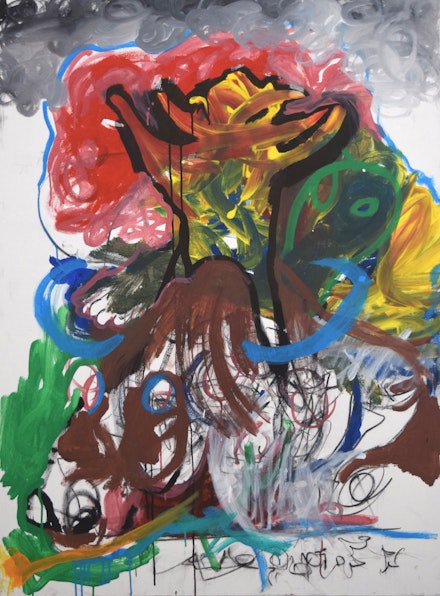
In this moment of social justice reckoning, we can also see Fountain House Gallery’s mission to eradicate stigma against those with mental illness as an important component of abolition. While the removal of carceral logics and practices does encompass prisons, it can also be broadly interpreted to include migrant detention centers and, as disability justice activists argue, hospitals and other residential institutions that isolate people on the basis of difference—such as mental illness. Likewise, it is impossible to ignore the multiple possible points of intersection that people with mental illness have with the criminal justice system—from high rates of incarceration and homelessness to tragic encounters with the police. As such, Fountain House Gallery’s public programming becomes an important component of shifting the public’s perception about mental illness.
Fountain House Gallery frequently collaborates with other organizations in this capacity to promote awareness of mental health issues and to destigmatize those living with mental illness. Most recently these collaborations have included working with the New York City Mural Arts Project (NYC MAP) on Some days I have to push myself/Say hello!, a mural that was designed to cover both sides of the Port Authority Bridge on 34th Street between Ninth and 10th Avenues in 2017. The brainstorming took place at Fountain House Gallery and painting was completed with community members under the direction of lead artist Andrew Frank Baer. Fountain House Gallery artist Anthony Newton created the mural’s main character, a Black painter, who was seen throughout the tableau. Fountain House Gallery artists also presented a special exhibit in 2018 at the Jewish Community Center’s Laurie M. Tisch Gallery on the Upper West Side to highlight the creativity of those living with mental health issues. And in February 2020, Fountain House artist Osvaldo Cruz was selected by the Saks Fifth Avenue Foundation to install “We Are Not Alone,” a series of spray-painted graffiti-inspired images of New York City in the store’s windows to bring attention to the difficulties that people living with mental illness face.
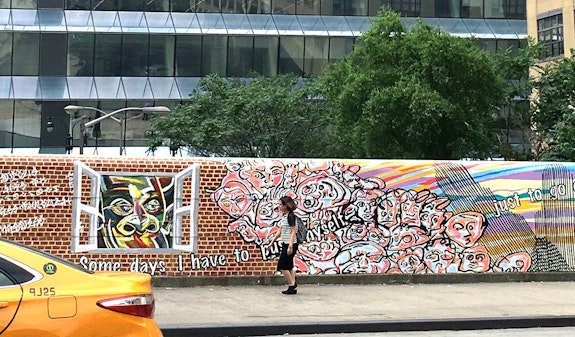
This particular season is an anxious time for most, with many experiencing increased challenges to their mental health and experts anticipate rates of mental illness to increase dramatically in the wake of the COVID-19 pandemic. Last year’s lockdown moved all of the Fountain House Gallery’s programming—including the studio classes and exhibitions—online, where they remained until a phased reopening began in mid-June. Many exhibitions have been themed to the present moment including Art in Quarantine (May 28–July 8, 2020); Let America Be America (September 24–November 11, 2020), a series of ruminations on politics and race; and Come On Home (January 15–February 17, 2021), which invited artists to present work related to their experiences of home, where many people have spent a great deal of time. Although moving exhibitions online shifts the viewer’s physical relationship to the artwork, it also allows more people access to the artists’ work. In addition to meeting several times a week online, the studio program also sent supplies to artists—a powerful tool in reducing isolation, fostering support, and continuing creativity. Reflecting on this moment, artist Rachel Eliana says in a Fountain House Gallery Instagram post that the organization is important because “it's somewhere that I can belong. It's like a neighborhood full of people who help each other."

In the midst of this virtual pivot, Fountain House Gallery celebrated its 20th anniversary in June 2020. In celebration it launched its 20th Anniversary Exhibition, curated by Other Content, a curatorial collective of NYU’s Steinhardt School, on Instagram. The exhibition was divided into three sections: Our People Our Life, which focuses on the defining moments, emotional lives, and coping mechanisms of the artists as they grapple with mental illness; Our Community Our City, consisting of images of the Fountain House Gallery and other community spaces to emphasize the value of coming together; and Our Present Our Future, a wide-ranging set of pieces that reflect on individual and collective moments of possibility. It is a glorious assemblage of art and voices. In a moment when Fountain House Gallery’s mission is even more urgent, thanks to their existence, we are privy to creative insights on coping, building community, and being oneself. In the words of artist Lucinda Fernández in another Instagram post, “Fountain House gave me friends, a voice to be heard, and a sense of expression through art.”
Among the works on display in the virtual exhibition, I find myself especially drawn to Susan Spangenberg’s 2019 mixed media piece (originally titled NYC: Sewing the Divide and changed for the exhibition to My Community), which features felt cut-outs of multi-hued people, small felt taxis, the New York City skyline, and an applique flower garden. Spangenberg says that it is her “attempt to bring people together as a community, despite our division in wealth and race.” The full Instagram caption also notes that the piece was “inspired by, and also a tribute to the work and life of beloved John Lennon. Susan displayed the overreaching orange Hudson Yard buildings as a metaphor for the division of social class, while ‘race exemplified by multicolored people circling around ‘Strawberry Fields’.’” The work sutures its wish for social and racial justice to its joyous exploration of textures and shapes. Above all, it exemplifies individuality and pleasure in creativity.

